Redness of the Face
Identifying possible causes and solutions
Medically reviewed by Susan Bard, MD
Redness of the face is a symptom many people experience. The most common causes include rosacea, acne, and autoimmune diseases. But other things can also cause a face that's always red.
Some clues about the cause may lie in the location of redness. For example, cheek, forehead, or nose redness may each point to different causes.
This article explains the causes, symptoms, and treatments of face redness.
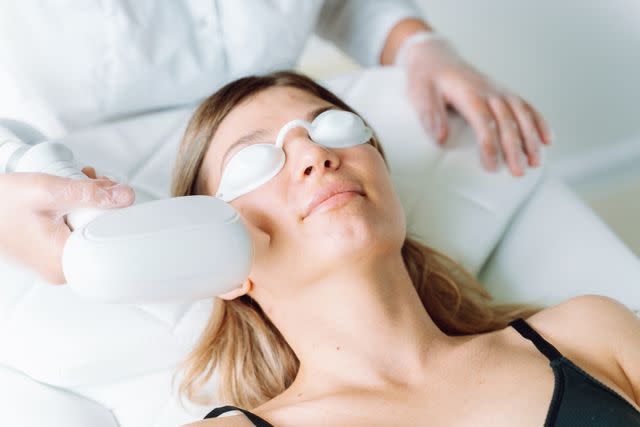
Olga Rolenko / Getty Images
Causes of Face Redness
If you wonder why your face is always red, where the redness is concentrated may provide some clues as to its cause.
Cheeks
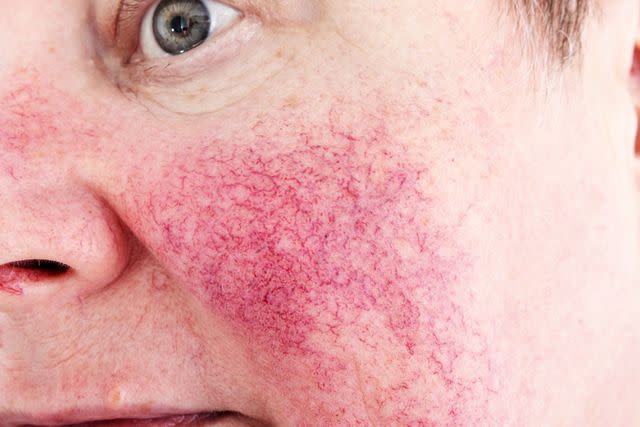
Lipowski / Getty Images
If your face redness is concentrated on your cheeks, the following conditions may be to blame:
Acne
Rosacea (a chronic inflammatory skin condition that causes face redness)
Contact dermatitis (allergic reaction from coming into contact with an irritant)
Atopic dermatitis (eczema)
Spider veins (a circulatory condition that causes spidery-looking veins, usually seen in older people)
Shingles rash (a painful, itchy rash that occurs with the herpes zoster virus)
Lupus (an autoimmune disease that can sometimes cause a "butterfly mask" across the cheeks and nose)
Sézary syndrome (a rare type of cutaneous T-cell lymphoma)
Many of these causes are not isolated to the cheeks; some can also be found in other areas of the face.
What Causes Sudden Rosacea Flares?
Some common triggers that lead to rosacea flares include:
Sunlight
Stress
Heat
Alcohol, especially red wine
Spicy foods
Some skin and hair care products
Some makeup
Wind and cold
Some medicines
Exercise
Around the Nose
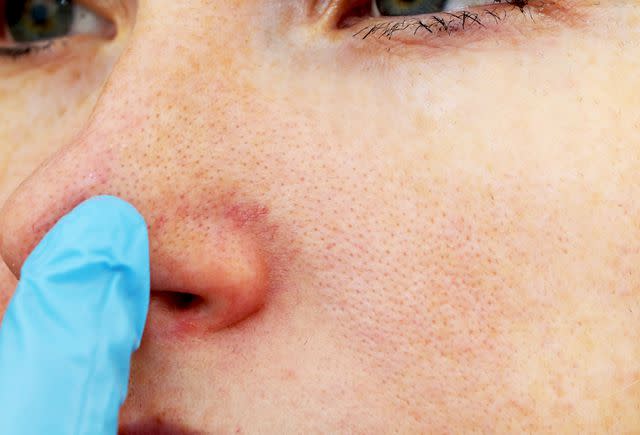
Alona Siniehina / Getty Images
Some of the same causes related to the cheeks can also cause facial redness around the nose. Red nose causes include:
Acne
Rosacea
Spider veins
Shingles rash
Lupus
Sézary syndrome
Wind, cold, sun
Allergies or illnesses that result in nose-blowing
Rhinophyma (a severe form of rosacea that affects the nose)
Nasal vestibulitis (a nasal infection that causes redness inside and outside of the nostrils)
One of the biggest standouts for nose redness is that it is more affected by the weather. So, if you are exposed to cold wind or time in the sun, you may notice a red nose.
In addition, anything that causes you to blow your nose frequently—whether it's allergies, illness, or crying—can also result in a red nose.
Forehead
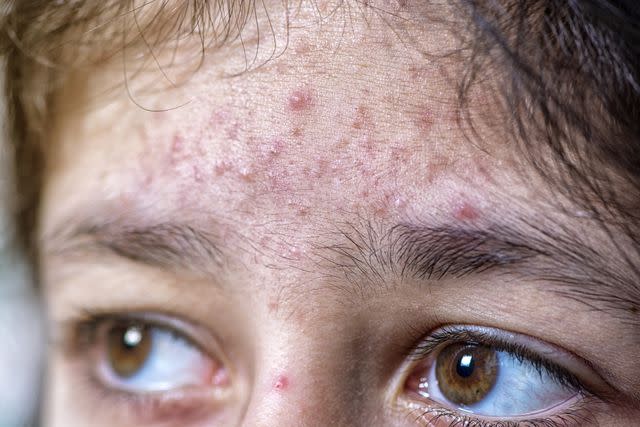
AHMET YARALI / Getty Images
Forehead redness can also result from some other common causes of face redness. There are also some causes more specific to foreheads. Causes include:
Spider veins
Shingles rash
Sézary syndrome
Acne
Seborrheic dermatitis (skin inflammation and redness that occurs on and around the scalp)
Folliculitis (a skin condition that affects hair follicles)
Impetigo (a bacterial skin infection)
Psoriasis (a condition that causes a thick, scaly, red rash)
Though psoriasis can appear anywhere on the face, it may affect the forehead, especially if you have scalp psoriasis along the hairline. The same is true for folliculitis.
Heat-related issues, like heat rash, may be more pronounced on the forehead. In addition, because you sweat more on your forehead than other parts of your face, impetigo and acne may be more prominent there.
Eyelids
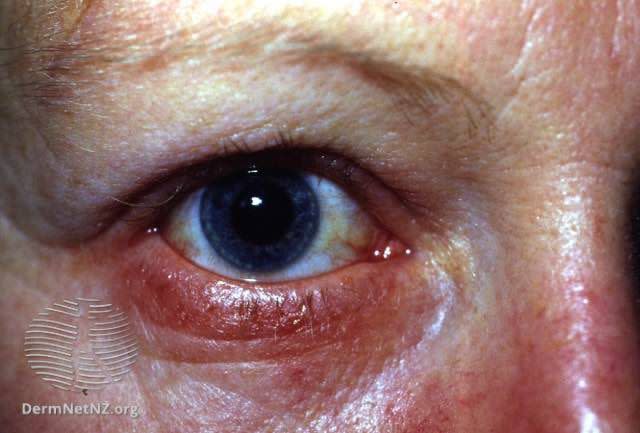
DermNet / CC BY-NC-ND
BlephartisCertain kinds of redness may be seen on the eyes. These include:
Rosacea
Contact dermatitis
Atopic dermatitis
Blepharitis (a condition that causes red, swollen, itchy eyelids)
Nonmedical Reasons for Face Redness
In addition to medical reasons for face redness, other nonmedical factors can lead to a red face, including:
Embarrassment
Crying
Feeling upset
Scratching
Face Redness From Medication
Face redness as a side effect of medication is called facial flushing. This may occur with many types of medications, including:
Opioids like morphine and codeine
Nonsteroidal anti-inflammatory drugs (NSAIDs) like aspirin, Advil or Motrin (ibuprofen), or Aleve (naproxen)
Flushing can also result from a medication allergy.
Symptoms: How Face Redness Looks
Accompanying face redness symptoms may vary depending on the cause. You may notice some of the following symptoms in addition to the redness:
Skin sensitivity
Flushing
Bumps
Visible blood vessels near the skin's surface
Thickened skin
Crusting
Itching
Burning
Flaking
How long will your face redness last? It depends on the cause. For example, if a heat rash or weather causes your face redness, it should resolve as soon as these conditions improve.
However, if your face redness results from a chronic condition, like eczema, psoriasis, rosacea, or lupus, you will need a treatment plan to manage your symptoms and reduce flare-ups.
Redness caused by an infection should clear up when the infection does.
Skin Redness on Different Skin Tones
Redness on the face can occur on all skin types and shades, but symptoms may be more prominent on light-colored skin. People with darker skin tones might notice the following:
A warm feeling
Dryness
Darker skin patches
A brown discoloration
Acne-like breakouts
Hard, yellowish-brown bumps
Burning or stinging
Swelling
Skin thickening
How to Minimize Face Redness
Depending on the cause, there are numerous ways to treat face redness. Some things as simple as lifestyle changes get rid of it.
Skin Protection
Protecting your skin from the sun, wind, and cold can help prevent sun damage and weather-induced redness. Try incorporating the following into your daily routine:
Apply sunscreen every day.
Wear a hat when in the sun.
Stay in the shade.
Avoid the sun during peak hours (midday).
Related: The 10 Best Sunscreens for Sensitive Skin
Know Your Triggers
If you have a condition that involves flare-ups, like psoriasis, eczema, or rosacea, try to identify the things that trigger them. This can help you avoid or minimize them.
Related: Causes and Triggers of Eczema
Have a Good Skin Care Routine
A good skin care routine can also go a long way to resolve or prevent face redness. Only use mild facial cleaners on your face, never soap, which is too harsh and drying for facial skin. Gently rub with your fingertips and rinse with lukewarm water.
Related: Are You Allergic to Your Skincare Products?
Laser Treatment
If you have spider veins, rosacea, or acne, laser treatment may help. According to the American Academy of Dermatology, lasers may reduce face redness by about 20%.
Related: Types of Cosmetic Laser Procedures
Medication
If you have an infection, you may need antibiotics to clear the infection before you notice your face redness symptoms disappear. Similarly, if you have a chronic health condition, like lupus, medication may help manage your symptoms.
Conversely, if you take medication that causes flushing, you may need to discuss alternatives with a healthcare provider. There may be another medication that doesn't have flushing as a side effect. If your medication is for treating an acute condition, your face redness should resolve when you finish your medication.
Related: Drug and Medication Side Effects
When to See a Healthcare Provider
You should see a healthcare provider if at-home measures or chronic health condition management doesn't work to reduce your face redness. Something else may be causing it, or you may need a different treatment approach.
If you are experiencing sudden facial flushing with other symptoms, such as oral swelling, shortness of breath, and feeling faint, you may be experiencing anaphylaxis (a severe allergic reaction). Seek medical attention immediately.
Summary
Redness on the face can have many causes, including chronic health conditions, acne, infections, allergies, and skin sensitivities. Face redness may be accompanied by other symptoms, depending on the cause. You may also experience itching, burning, crusting, and flaking.
Seek a healthcare provider for ongoing facial redness to have the underlying condition diagnosed and managed.
Read the original article on Verywell Health.

